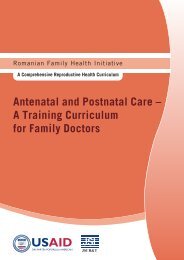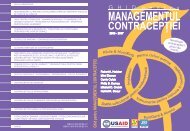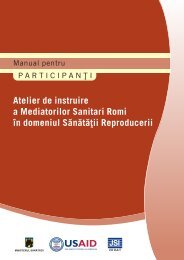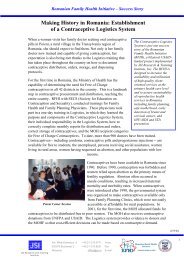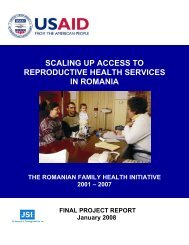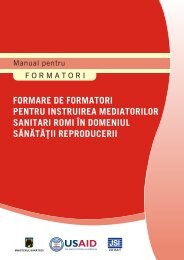Training of Roma Health Mediators in Reproductive Health
Training of Roma Health Mediators in Reproductive Health
Training of Roma Health Mediators in Reproductive Health
You also want an ePaper? Increase the reach of your titles
YUMPU automatically turns print PDFs into web optimized ePapers that Google loves.
personal questions.<br />
• Recognize that when we ask certa<strong>in</strong> questions, especially concern<strong>in</strong>g attitudes and<br />
feel<strong>in</strong>gs, what is important is that the woman beg<strong>in</strong>s to th<strong>in</strong>k about her response.<br />
Whether or not she decides to share her response may not be important.<br />
Ask the group:<br />
‣ What are some <strong>of</strong> the reasons we ask women questions dur<strong>in</strong>g discussions <strong>of</strong><br />
reproductive health?<br />
• To understand reproductive health practices <strong>of</strong> women<br />
• To assess women’s knowledge <strong>of</strong> recommended reproductive health practices<br />
• To help women make decisions<br />
• To help women to anticipate consequences if certa<strong>in</strong> decisions are made<br />
• To help woman act after hav<strong>in</strong>g made decisions<br />
‣ What are some questions you might ask a woman about reproductive health?<br />
Note several examples on a flip chart. Most will likely be closed questions. Ensure<br />
there are at least 2 open questions.<br />
‣ What k<strong>in</strong>ds <strong>of</strong> responses can one give to these questions?<br />
Often a "yes", "no" or a fact. The response to a question <strong>in</strong>dicates the k<strong>in</strong>d <strong>of</strong> question<br />
asked:<br />
• closed question: only 1 answer is possible<br />
• open question: several answers are possible<br />
Draw attention to the open questions and the fact that they serve to:<br />
• Ask for more <strong>in</strong>formation/specifics<br />
• Help the woman identify possible alternatives and weigh the pros and cons <strong>of</strong> each<br />
• Help the woman reflect on her situation, on her feel<strong>in</strong>gs and values, on her behavior<br />
• Give more structure to the discussion.<br />
Demonstration <strong>of</strong> the use <strong>of</strong> open questions. Two tra<strong>in</strong>ers demonstrate the use <strong>of</strong> open<br />
questions (us<strong>in</strong>g a reproductive health example). (2 m<strong>in</strong>utes)<br />
Ask the group:<br />
‣ What did you observe?<br />
‣ In what ways did open questions contribute to communication between the mediator<br />
and the woman <strong>in</strong> the community?<br />
Open questions help the mediator:<br />
• To understand reproductive health practices <strong>of</strong> women<br />
• To assess women’s knowledge <strong>of</strong> recommended reproductive health practices<br />
214<br />
RFHI/JSI <strong>Roma</strong>nia <strong>Tra<strong>in</strong><strong>in</strong>g</strong> <strong>of</strong> RHMs <strong>in</strong> <strong>Reproductive</strong> <strong>Health</strong> Session 14: Interpersonal Communication



